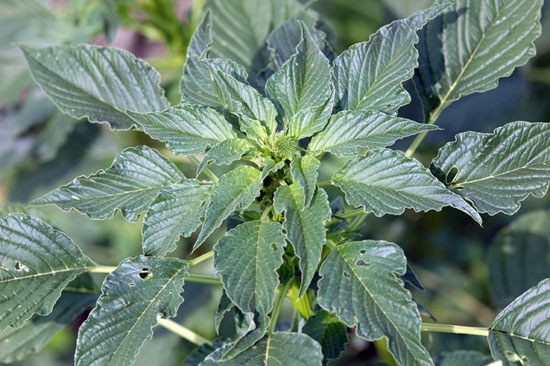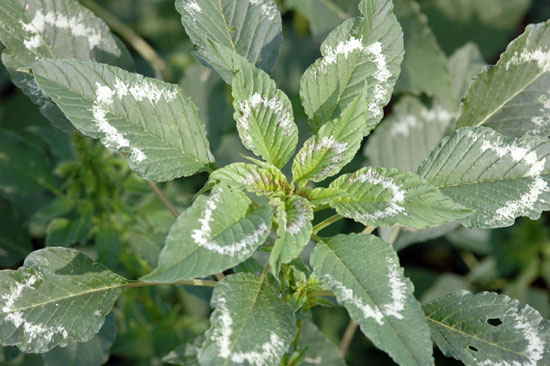Issue 8, June 23, 2014
Palmer Amaranth -- A New Weed to Watch For
Ask any cotton farmer what has been their biggest weed problem of recent years and they will all likely tell you the same: Palmer amaranth (Amaranthus palmeri). This plant has put some southern farmers out of business. Midwest farmers are now or will soon be well acquainted with this fast growing and yield robbing species as it is moving northward across the Midwest. I have not had reports of this weed being found in landscapes but it is only a matter of time as related Amaranth species such as redroot pigweed and smooth pigweed commonly make landscape beds their home.
Palmer amaranth is a summer annual, growing erect and branching to heights of 6 to 8 feet or more. Although Palmer amaranth resembles other more common pigweeds, there are a few characteristics that make it stand out. The plant has a poinsettia-like appearance with symmetrical leaf arrangement. The leaves will often have a v-shaped variegation. The petioles are quite long and can be longer than the leaf blade. The stems and leaves are smooth and without hairs. The flowering structure is 1 to 2 feet long and measured in feet not inches as the others are!
Recently, University of Illinois Weed Specialist Aaron Hager wrote about the growth rate of Palmer amaranth in the Bulletin at http://bulletin.ipm.illinois.edu/?p=2024. The article features pictures taken by Cody Evans, a U of I weed science graduate student and they are impressive! Over the course of 16 days, the growth rate is compared and visualized between Palmer amaranth and waterhemp.

The poinsettia-like appearance of Palmer amaranth (photo by Aaron Hager).

Watermark or V-shaped variegation on the leaves of Palmer amaranth (photo by Aaron Hager).
To help document the rate of growth of this weed, this year researchers at Purdue University are using a trail camera to take pictures of the weed every 5 minutes. According to an article on www.agprofessional.com, in only a week’s time, they witnessed Palmer amaranth go from a very manageable weed to a weed that may only be marginally controlled with our available post-emergence herbicides. Just a few days more and producers may not be able to control it at all. In only one week, the plants grew from 1 to 1.5-inches in height to 5 to 6-inches in height. It is understandable then why producers should be concerned and monitoring their fields often.
There is concern that unidentified Palmer amaranth plants could be allowed to grow in landscape beds where its growth can quickly get out of hand. Once seed are produced, the problem will return for years to come. This plant also is highly tolerant of heat and drought. So it will grow well in July and August when some of our garden plants (and gardeners) have had enough of the weather extremes and are looking ragged and tired. Many landscape beds are given up on about this time of year.
Corn and soybean producers are encouraged to use preemergent herbicides specifically for prevention of this weed in certain locations. At this time, we are not recommending the same for landscape professionals. However, be on the lookout for this new weed. Proper identification is essential. A good reference to use is Kansas State University’s pigweed identification pictorial guide found at http://www.ksre.ksu.edu/bookstore/pubs/s80.pdf. Additionally, Purdue University has a nice video, “Identifying Palmer Amaranth in The Field” at https://www.youtube.com/watch?v=aVbgPGg0GO0. The U of I has set up a service to help farmers identify the plant in their fields and test whether it is resistant to common herbicides. For more information about that, go to http://bulletin.ipm.illinois.edu/wp-content/uploads/2013/09/Palmer-Amaranth-ID-Form2.pdf. Plants may be physically removed – the earlier the better. Certainly, do not allow plants to flower and produce seed as one plant can produce over 100,000 seeds in a season. Unfortunately, Palmer amaranth is reported to sometimes be resistant to glyphosate which is a commonly used non-selective postemergent herbicide in landscapes. (Michelle Wiesbrook)
Resources:
http://www.agprofessional.com/news/Purdue-weed-scientists-explain-rapid-growth-of-Palmer-amaranth-263692821.html
http://news.illinois.edu/news/14/0603palmer_amaranth_AaronHager.html
Author:
Michelle Wiesbrook